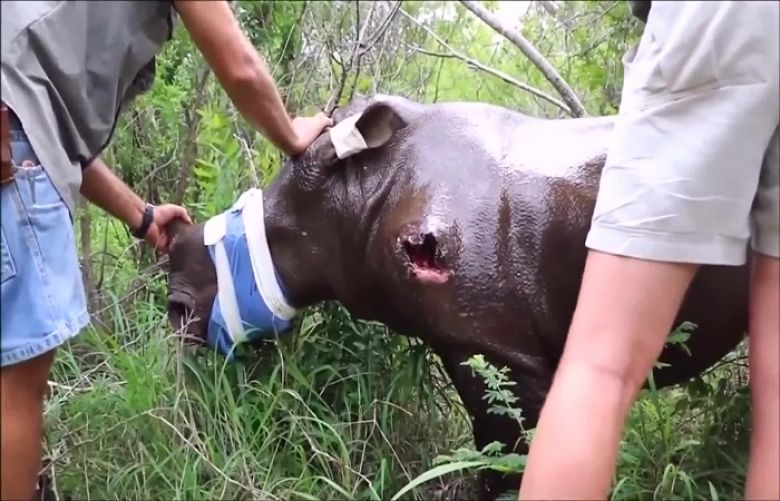After being shot by and escaping from the same poachers who killed her mom, an injured and orphaned 10-month-old female rhino was rescued and brought to a rhino sanctuary after an eight-day search across a private game reserve outside of Kruger National Park in South Africa.
The calf suffers from a fist-size gunshot wound to her left shoulder, says Albertus Coetzee, a veterinarian who was part of the rescue. The calf is currently recovering at Center for Wild Rhinos, a sanctuary that takes care of and rehabilitates rhinos and is an official agent of Care for Wild Africa.
The calf’s long-term prognosis is said to be good, and the center’s owner, Petronel Nieuwoudt, says the recovery should take around one month.
“We are sitting with her, we are feeding her,” Nieuwoudt says. “She is walking around and drinking water.”
The calf is receiving feedings several times a day, including at 2 a.m. and at 5 a.m.
The management team at the private game reserve contacted the sanctuary to aid in the rescue after the mom had been reported poached, says Gary Schneider, director of the advocacy group Working With Rhinos. After the team heard about the shooting they began looking for the baby in the reserve.
“It was an immense team, from the helicopter pilot to the drone pilot to the fixed-wing and microlight pilots ... guys on the ground,” Schneider says. “It was an immense team that did not give up.”
Trackers had found the calf’s tracks, which gave the team an idea where she might be, but unfortunately rain washed most of them away, says Schneider, who filmed the rescue. It took eight days for the team to find the baby rhino.
Coetzee was in a helicopter when they spotted the baby rhino running close behind a bull, one of several rhinos that can be found on the game reserve.
“We saw the bull first, and then we saw the little one running behind,” he says. “I think she must have seen the bull as her companion, so I think she was actually ... quite comfortable even though she was wounded.”
The fact that she seemed to be running strong was a good sign for Coetzee, as it hinted at a positive long-term prognosis. In order to safely transfer the calf back to the sanctuary, Coetzee darted her from the helicopter to sedate her.
Once the baby was darted, she was then guided into a crate that was loaded onto a vehicle and then transferred to the sanctuary, which is about 90 miles or 1.5 hours away by car.
At the sanctuary, the calf had her wounds cleaned and was put on antibiotics and IV fluids. She is closely monitored, because she is still too young to survive on her own. Yet once she is nursed back to a healthy and stable condition, the rhino will be released into a rhino stronghold that is defended from poachers, Schneider says.
“Definitely she must go back with other rhinos and she must be out and about so that she can breed and be a happy rhino,” Nieuwoudt adds.
Rhinos are killed in staggering numbers due to the value of their horns—made from keratin, the protein that’s in your nails and fingernails—through illegal wildlife trade. The demand comes largely from Asia, particularly Vietnam, where horns are seen as a status symbol or falsely thought to have medicinal value.
Oftentimes poachers will kill a calf or paralyze it by striking its spine to keep it from returning to its mother’s carcass, and thereby drawing attention to it. In some cases, the poachers may also take the baby’s tiny horn.
The calf that was rescued and brought to the center had only one front horn that was less than an inch long, Coetzee says. She was too young to have developed a second horn.
Attempts to legalize the international sale of rhino horns failed earlier this year at the September/October Convention of the International Trade in Endangered Species of Wild Fauna and Flora, or CITIES.
"People mustn’t underestimate what animals are going through ... The world must step up," Nieuwoudt says.

